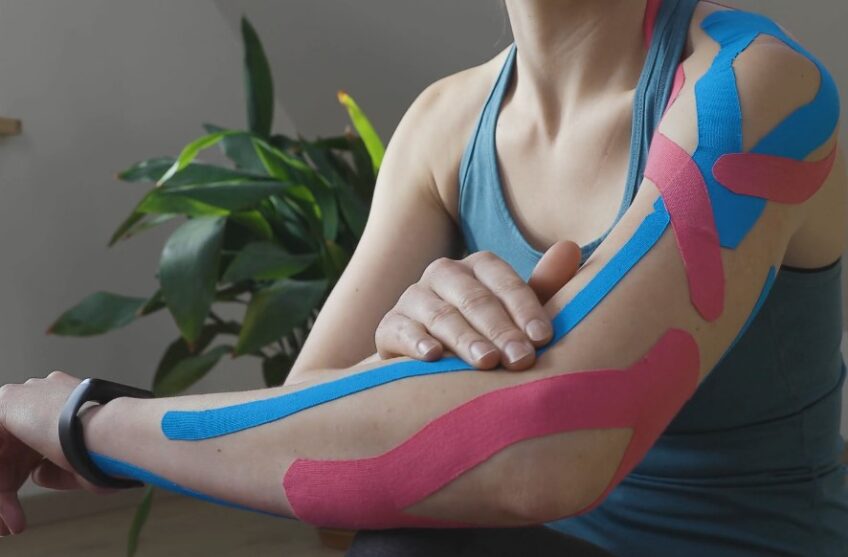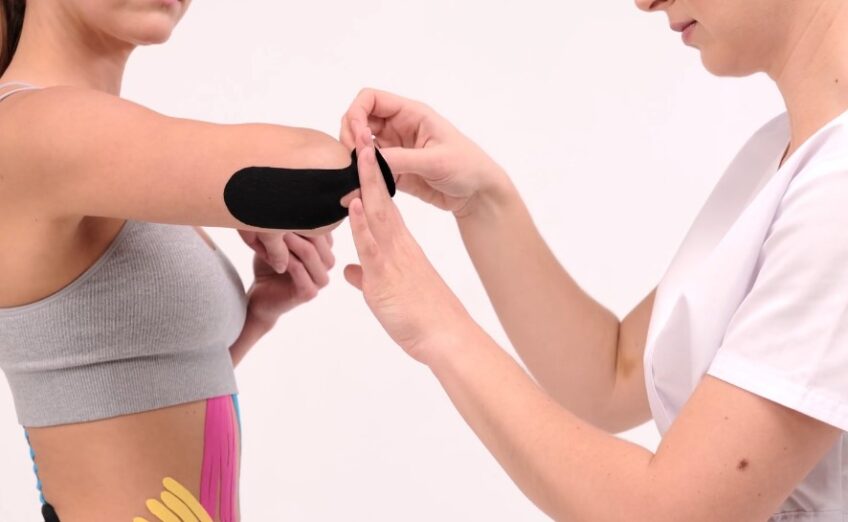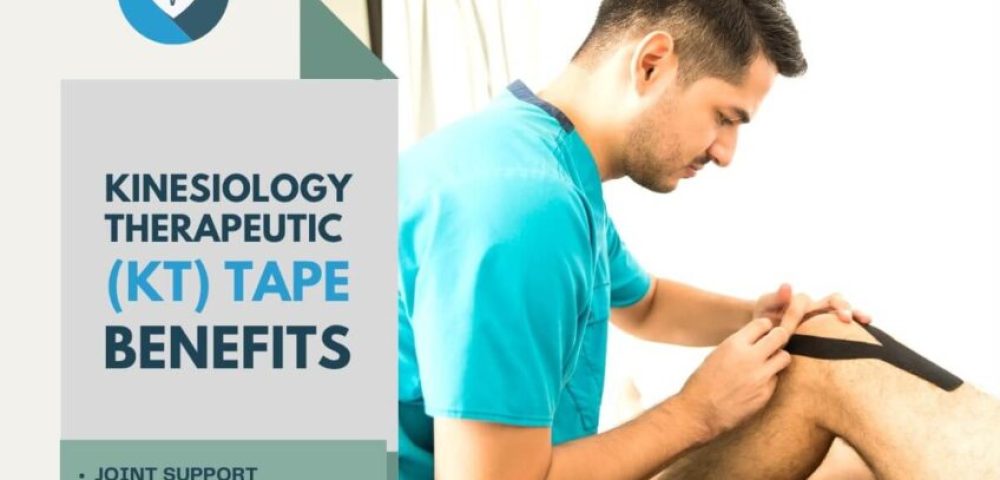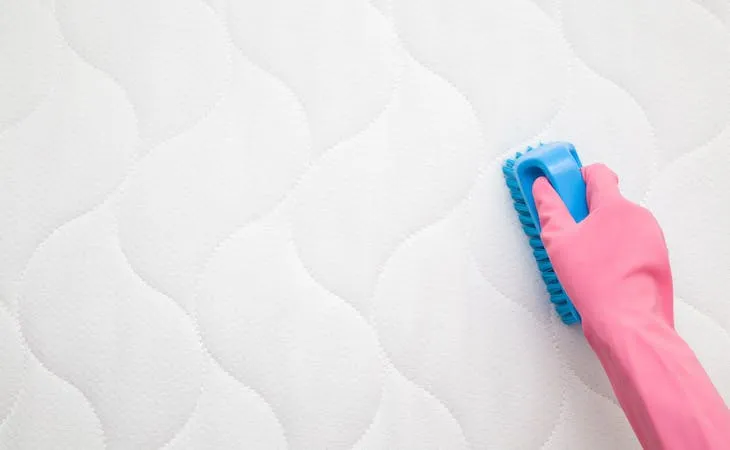We’ve all seen it. The guy or the girl in the gym or running outdoors with the tape running in all directions? Maybe you’ve seen them across the shoulder, around the knee cap, or on the back of calves and wondered what is that stuff?
It’s certainly not the ACE wrap we grew up with when I was injured. Does placing a piece of tape on you actually provide performance benefits? Well, turns out Kinesiology Therapeutic (KT) tape has numerous benefits. Education is power.
Let’s take a closer look at what Kinesiology Therapeutic (KT) can do for you.

KT tape is a specialized elastic sport and fitness tape designed for muscle, ligament, and tendon pain relief and support. The breathable cotton fabric features an acrylic adhesive that allows the tape to stretch up to 180%, providing stability without limiting motion.
It is applied to areas of the body that are causing discomfort or require extra support; it supports muscles during activity while helping reduce swelling. KT tape has been used in professional sports since 2016 and can be seen on athletes across various sports such as football, basketball, and track & field. Since its inception, it has become increasingly popular with amateur athletes as well.
It can be used to prevent or treat common muscle and joint-related injuries including sprains, muscle strains, subluxations, and tendonitis. KT tape provides support and pain relief before, during, and/or after an activity.
Its wide variety of uses includes:
- joint support of the knee, shoulder, ankle and wrist;
- relief from plantar fasciitis (heel pain);
- decreased swelling resulting from soft tissue damage;
- improved circulation for increased healing;
- reduced pressure on sensitive areas caused by neuropathy or poor posture;
- improved range of motion for injuries such as tennis elbow;
- lumbar stabilization for lower back pain;
- rotator cuff support for shoulder injuries;
- improved posture through spinal column reinforcement;
- even improved circulation from poor circulation due to diabetes or MS.
KT tape can be worn almost anywhere on the body-underneath clothing if desired-while still providing targeted relief where it’s needed most.
The range of motion is not limited. KT tape-with the body’s ability to heal itself can provide therapeutic relief to a variety of populations and diagnoses.
Page Contents
How Does It Work?

During injury blood and other fluids build up causing inflammation and swelling. If there’s too much inflammation, excess is unable to be removed by the lymphatic system. In short, the lymphatic vessels become compressed which prevents oxygen and nutrients from being delivered to healing tissues.
When KT tape is properly applied, the elasticity in the KT tape gently lifts the skin from the tissues below. This gentle lifting of the skin creates a space to improve blood and lymphatic flow which ultimately helps to alleviate pressure and reduce swelling.
Once blood flow is restored, oxygen and nutrients are better able to reach damaged tissues to help enhance healing.
As a result, there are other benefits to KT taping besides pain relief and reduction of inflammation. KT tape is also used to support injured muscles or joints without restricting the full range of motion in individuals with neurological disorders.
It helps to aid in faster muscle recovery, prevents cramps or spasms, prevents over-stretching or over-contraction of muscles, and also enhances muscle tone and strength.
KT tape comes in a variety of colors. Pick a color that matches your shoes or shirt! Just don’t go overboard and makeup injuries to have every single color on you.
If you’re a runner who needs knee support or someone who just wants to walk without pain, ask your PT, PTA, or ATC if KT tape is right for you.
Benefits

When applied correctly in strips along the surface of an injury site and stretched out beyond its resting length during the application process, KT tape helps to relax overworked muscles and reduce inflammation from an injury.
Benefits of KT tape:
– Reduces muscle pain and inflammation
– Improves circulation in targeted areas
– Relieves pressure on nerves/joints caused by repetitive motions
– Stabilizes weak or injured muscles
– Enhances proprioception (the understanding of where one’s body is in space)
– Prevents muscle strain and overuse injuries
– Supports lymphatic drainage (the natural process the body uses to remove waste products from cells)
If you have major problems with nerve pain, you should consider dry needling piriformis therapy for relieving yourself from chronic pain.
How to Apply KT tape

Kinesiology tape provides extra support so you can stay in motion and focus on the activities you love.
The key to successful taping is proper application. To effectively use it, it’s important to pay attention to the taping technique, start with a clean area, and ensure that you adjust the tension appropriately for your body and activity level.
Below are some general instructions for applying KT tape:
1) Clean the application area with soap and water before applying the tape.
2) Cut 1-2 inch (2.5 – 5 cm) pieces of tape based on the size of the area being treated (smaller areas typically require smaller pieces).
3) Align one side of the tape lightly onto the skin without stretching it. This forms an anchor point for other strips of the same piece or different strips applied consecutively.
4) Peel away roughly half of the paper while keeping your other hand extended forward over where that piece will be placed.
5) Apply with hands firmly on the person’s skin in direction of adhesive flow as indicated by arrows printed directly on the back paper side in center strip patterning then, insert middle fingers behind the stretch tension panel below the adhesive backing while simultaneously engaging the anchor points onto skin surface.
6) Gently press down ends at each end ensuring secure placement onto skin tissue avoiding twisting or bending forces from occurring during the application process eventually moving into rubbing along each flap; For best results, this should be performed using a thumb pushing up against the perimeter edges for quick even coverage throughout desired area targeting various muscle groups such as legs, arms, neck & back etc.
7) Ensure completion by peeling away the remaining back plastic side to the uninvolved person’s hand allowing middle finger removal applied directly next following patterns already depicted earlier.
FAQ

Who should use KT tape?
Anyone suffering from sore muscles or joint pain due to minor sprains/strains or chronic inflammatory conditions like osteoporosis can benefit from using KT tape.
However; it’s best if those people see a medical professional before using this sort of treatment as well as get educated on proper application techniques for different types of issues for best results in treating their specific condition/injury properly.
Can you wear kinesiology tape to bed?
Wearing kinesiology tape to bed may provide short-term relief from pain and may help you get a good night’s sleep. However, it is important to note that wearing kinesiology tape to bed should only be used as an occasional treatment option and should not be relied on as a sole source of relief.
What are the side effects of KT tape?
KT tape has been shown to have a number of side effects, including:
1. Pain and swelling
2. Feeling pressure or tightness on the skin
3. It can be difficult to remove KT tape from the skin
Is KT tape anti-inflammatory?
KT tape has been shown to be effective in reducing inflammation, which is thought to be due to the tape’s ability to restrict blood flow.
Conclusion
The use of kinesiology therapeutic tape is becoming increasingly popular for treating and preventing injuries and providing relief from muscle pain. It can be used without medication or surgery to help improve range of motion, posture, joint alignment and reduce swelling. KT tape is an easy-to-use sports recovery tool that has a variety of potential benefits for athletes and active individuals.
In conclusion, for more information on therapy support check out fischerinstitute.com.
Astrona Knight is the Editor-in-Chief at Fischer Institute, where she shares her extensive knowledge on health and wellness topics. Her insightful articles cover everything from diet and nutrition to mental health, providing readers with practical tips and the latest research findings.
Also Read:
- How Much Does An Almond Weigh - Benefits of Almond
- Benefits And Side Effects of Onions: Peeling Back the Layers
- Major Side Effects of Eating Too Many Mung Bean…
- Activated Charcoal for Food Poisoning: Benefits and…
- 10 Health Benefits of Wonton Soup: Delicious and Nutritious
- 7 Benefits of Homemade Baby Food - Tiny Taste Explorers















